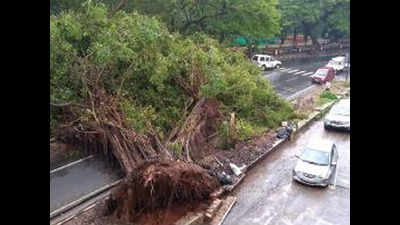Trending
This story is from November 11, 2019
Corporation of the City of Panaji stumped over replacement of fallen trees
For decades, the stately trees dotting Panaji have been an integral part of the city’s heritage landscape. Citizens have developed an emotive relation with them, especially the rain trees (Samanea saman) which add to the natural beauty and provide shade and shelter to birds and humans alike.

Many trees did not develop strong roots due to concrete surroundings
PANAJI: For decades, the stately trees dotting Panaji have been an integral part of the city’s heritage landscape. Citizens have developed an emotive relation with them, especially the rain trees (Samanea saman) which add to the natural beauty and provide shade and shelter to birds and humans alike.
While the prospects of an increasingly grey landscape, in the name of development, is always a cause for worry for citizens, this time around, it was an act of nature, the cyclonic storm Kyarr, which knocked down a few of these green landmarks.
Lamenting the loss, the Corporation of the City of Panaji’s biodiversity management committee, at a recent meeting, discussed steps to protect the city’s green cover. “Many trees, especially the wide-canopied rain trees which enhance the ambience of the promenade and the city, fell during the storm. These trees have a shallow tap root system and they can be affected by strong cyclonic winds,” a committee member said. “Many of these trees have not developed adventitious roots, which can support them well, due to hard ground — tar and concrete — around them,” another member said.
One consideration discussed was that of planting similar species of trees. This however, failed to find favour. “Considering that the median space in which the trees stand has reduced due to widening of roads, it is debatable whether similar trees, especially rain trees should be planted,” horticulturist and BMC member Daniel D’Souza said. The committee is now considering alternative forest tree species.
Around 15 years ago, when the government proposed to axe 37 of these trees to widen the road between Campal and Miramar, citizens responded with a vociferous protest, forcing the government to withdraw its decision. On its part, the civic body has failed to suitably follow the recommendations made by WWF for the maintenance of these trees.
“We had suggested scientific pruning, supervised by botanists,” Sawant said.
While the prospects of an increasingly grey landscape, in the name of development, is always a cause for worry for citizens, this time around, it was an act of nature, the cyclonic storm Kyarr, which knocked down a few of these green landmarks.
Lamenting the loss, the Corporation of the City of Panaji’s biodiversity management committee, at a recent meeting, discussed steps to protect the city’s green cover. “Many trees, especially the wide-canopied rain trees which enhance the ambience of the promenade and the city, fell during the storm. These trees have a shallow tap root system and they can be affected by strong cyclonic winds,” a committee member said. “Many of these trees have not developed adventitious roots, which can support them well, due to hard ground — tar and concrete — around them,” another member said.
One consideration discussed was that of planting similar species of trees. This however, failed to find favour. “Considering that the median space in which the trees stand has reduced due to widening of roads, it is debatable whether similar trees, especially rain trees should be planted,” horticulturist and BMC member Daniel D’Souza said. The committee is now considering alternative forest tree species.
Most of the older trees were planted during the Portuguese era, when the city’s highly-acclaimed grid road system was laid. Later, the World Wide Fund for Nature (WWF) studied Panaji’s arboreal species in two separate surveys. Environmentalist Nandkumar Kamat and later WWF director Nitin Sawant had counted and documented the tree species.
Around 15 years ago, when the government proposed to axe 37 of these trees to widen the road between Campal and Miramar, citizens responded with a vociferous protest, forcing the government to withdraw its decision. On its part, the civic body has failed to suitably follow the recommendations made by WWF for the maintenance of these trees.
“We had suggested scientific pruning, supervised by botanists,” Sawant said.
End of Article
FOLLOW US ON SOCIAL MEDIA











